What sort of animal makes these tracks in the sand?
Snake? Lizard? Turtle? Continue reading
What sort of animal makes these tracks in the sand?
Snake? Lizard? Turtle? Continue reading
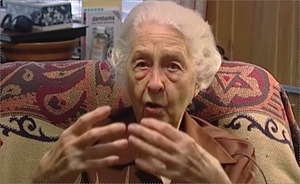 Here’s
a video about Elsie,
A Crusader for Conservation,
19 September 2014,
by Tennessee’s Wild Side, “The Emmy Award winning show produced through the generosity of the Jackson
Foundation, Tennessee State Parks, and the Tennessee Wildlife Federation.”
Lots of good pictures, some video snippets of Elsie, and some narration by her nephew Patrick and by Biologist Tom Hemmerly, who reminds us of Elsie’s work at Radner Lake, in addition to her cedar glades work.
Ranger Buddy Ingram explains her biggest contribution may have been
in getting numerous different segments of society to cooperate
in saving whole ecologies.
Botanist Kim Sadler and others explain how inspiring all that is to generations
of students.
Here’s
a video about Elsie,
A Crusader for Conservation,
19 September 2014,
by Tennessee’s Wild Side, “The Emmy Award winning show produced through the generosity of the Jackson
Foundation, Tennessee State Parks, and the Tennessee Wildlife Federation.”
Lots of good pictures, some video snippets of Elsie, and some narration by her nephew Patrick and by Biologist Tom Hemmerly, who reminds us of Elsie’s work at Radner Lake, in addition to her cedar glades work.
Ranger Buddy Ingram explains her biggest contribution may have been
in getting numerous different segments of society to cooperate
in saving whole ecologies.
Botanist Kim Sadler and others explain how inspiring all that is to generations
of students.
As Elsie said in 2006:
Continue readingThe general public needs to know what’s around them. They need to be learning that there’s a world that is not paved. There are lots of things that have life and function in the whole scheme, people as well as plants and animals. Not just dogs you’ve got on a leash, but animals that live out there, are part of the whole ecosystem.
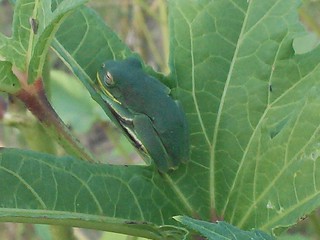 In what category does Georgia rank highest
In what category does Georgia rank highest
Guess first, then look (no peeking)…. Continue reading
 Derrick Dawson will talk about a long-time tradition at
South Georgia Growing Local 2014:
Derrick Dawson will talk about a long-time tradition at
South Georgia Growing Local 2014:
Continue readingThe Lowndes County Ham and Eggs show is the only remaining Ham and Eggs show in Georgia and one of only two in the country.
Hams are cured by a local team that travels periodically to Fort Valley State University to work in USDA certified facilities. Hams are treated with a cure, turned, treated, turned, treated, turned, washed, bagged and finally smoked over the course of several weeks in preparation for judging and auction.
Four talks have moved locations or times:
 Jerald Larson needed an earlier slot, so
Grow Your Own Organic Small Fruits has moved to 11:30 AM in Room 1.
Jerald Larson needed an earlier slot, so
Grow Your Own Organic Small Fruits has moved to 11:30 AM in Room 1.
 Composting needs a room with a tile floor, so
Composting: Red Wigglers and Soldier Flies by John Horton
has moved to 3:15 PM in Commons.
Composting needs a room with a tile floor, so
Composting: Red Wigglers and Soldier Flies by John Horton
has moved to 3:15 PM in Commons.
 A Walk with Dairy Goats: a lesson in humor and humility by Julia Shewchuk
has moved to 3:15 PM in Commons.
A Walk with Dairy Goats: a lesson in humor and humility by Julia Shewchuk
has moved to 3:15 PM in Commons.
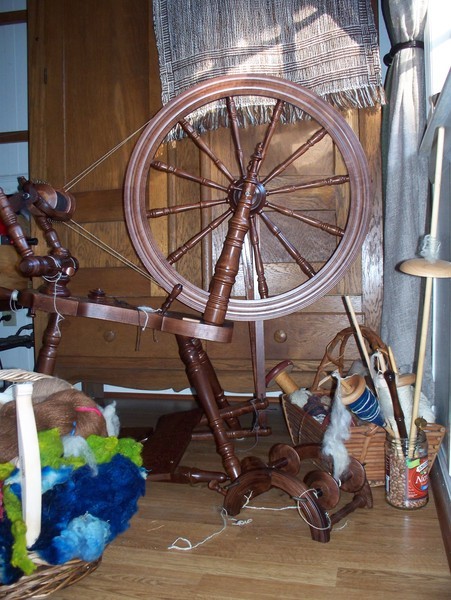 From Fabulous Natural Fibers to Flamboyant Fabric: the craft and art of hand spinning and weaving by Amy Brown
has moved to 11:30 AM in Room 2.
From Fabulous Natural Fibers to Flamboyant Fabric: the craft and art of hand spinning and weaving by Amy Brown
has moved to 11:30 AM in Room 2.
All these changes are in the revised schedule.
-jsq
We are now nearly at the conference and I can hardly tell you how excited I am. I had a final walk through of Pine Grove Middle School and Farm this week and got all the details for accessing their technologies and the Internet.
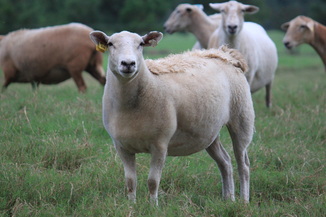 Farm Tours will be Friday, January 24th, including
Farm Tours will be Friday, January 24th, including
 produce at
Raisin’ Cane,
produce at
Raisin’ Cane,
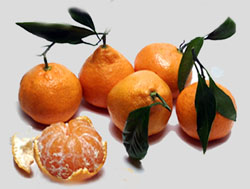 door yard citrus at
Loch Laurel Nursery,
olive oil and trees at
Georgia Olive Farms,
and
Katahdin sheep at
Hound River Farm.
door yard citrus at
Loch Laurel Nursery,
olive oil and trees at
Georgia Olive Farms,
and
Katahdin sheep at
Hound River Farm.
 Conference talks will be Saturday, January 25th, 9 a.m. to 6 p.m.
(Doors open at 8 a.m.) at Pine Grove Middle School,
4159 River Rd, Valdosta, GA 31605.
We will be able to tour
the hydroponic green houses at the school that day!
The
preliminary schedule is posted.
Conference talks will be Saturday, January 25th, 9 a.m. to 6 p.m.
(Doors open at 8 a.m.) at Pine Grove Middle School,
4159 River Rd, Valdosta, GA 31605.
We will be able to tour
the hydroponic green houses at the school that day!
The
preliminary schedule is posted.
 Most of our speakers are local (how lucky are we that we have this wealth
of talent in our community) and a couple from out of the have indicated
that they need a room. We have arranged
a discounted rate at two local hotels.
Most of our speakers are local (how lucky are we that we have this wealth
of talent in our community) and a couple from out of the have indicated
that they need a room. We have arranged
a discounted rate at two local hotels.
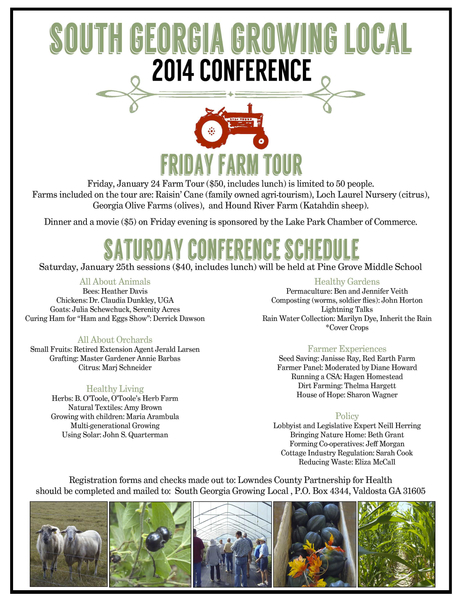 There is still plenty of room, so by all means, please continue to
invite those that you think will be interested in attending. The
Pine Grove Middle School is a lovely facility and we are lucky to be
able to use it.
There is still plenty of room, so by all means, please continue to
invite those that you think will be interested in attending. The
Pine Grove Middle School is a lovely facility and we are lucky to be
able to use it.
Don’t forget to register!
-Gretchen
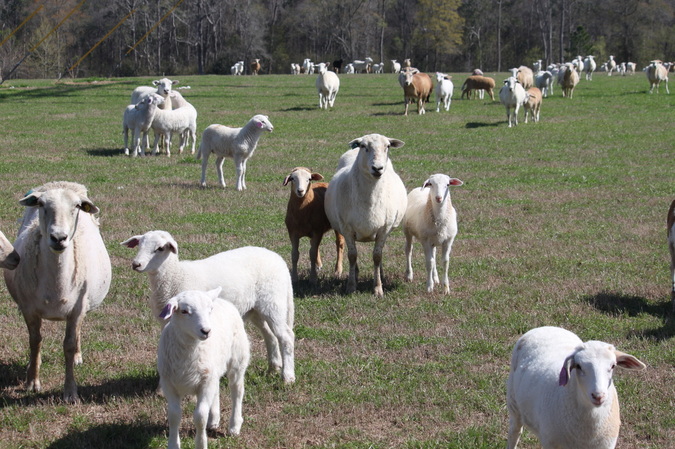 Not for wool, for meat, they raise Katahdin sheep;
we’ll visit Hound River Farm
on our Friday Farm Tour at
South Georgia Growing Local 2014.
Not for wool, for meat, they raise Katahdin sheep;
we’ll visit Hound River Farm
on our Friday Farm Tour at
South Georgia Growing Local 2014.
We raise registered Katahdin Hair Sheep on 240 acres in the coastal plains region of South Georgia. We are approximately 30 miles north of the Georgia-Florida border with easy access from I-75. Our farm consists of Bermuda and Bahia pastures, woodlands, and wetlands. We harvest our own Continue reading
 It’s not just for south Georgia:
from Madison County, Florida, Julia Shewchuk will talk about her
goats of
Serenity Acres Farm.
It’s not just for south Georgia:
from Madison County, Florida, Julia Shewchuk will talk about her
goats of
Serenity Acres Farm.
Here’s Wayne and Julia’s welcome to Serenity Acres Farm:
We are a small farm in Madison County Florida working toward the big goal of bringing you
locally grown products and farm raised products without the use of major pesticides, hormones and genetically modified components.
Our philosophy is simple: Grow and raise it locally and then offer only the freshest and best of what we produce.
The goats appear about a minute into this video, with milking about 2 and a half minutes in: Continue reading
 Looking for Longleaf: The Fall and Rise of an American Forest,
by Lawrence S. Earley
Looking for Longleaf: The Fall and Rise of an American Forest,
by Lawrence S. Earley
The tallest and strongest of pine trees, longleaf made great sailing ship masts , tar for caulking ships, and of course saw timber. How the early settlers cut down trees for houses and to clear land to farm. Their hogs and cows running loose in the woods ate the young longleaf, suppressing new trees for a hundred years. Then professional forestry took over, trying to suppress the fire that destroyed northern white pine forests, yet which preserves southern longleaf pine forests. The sad story of turpentine: we knew better, but we did it anyway.
The peculiar life cycle of a tree that starts out looking like a clump of grass, and can stay that way for decades, yet promotes and survives fire and can grow more than 100 feet tall and live for centuries. The thousands of species of plants, animals, and fungi the forest protects, many of them, like wiregrass, also adapted to fire.
How tuberculosis and quail led to new understandings of longleaf and fire, and the people who discovered those things. We do know how to grow these trees now, and lots of people are doing it: for jobs, for sawtimber, for the beauty of the forest.